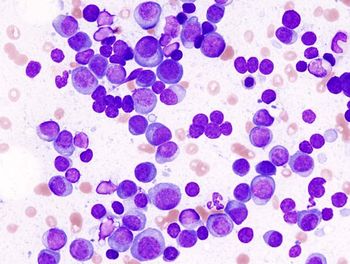
- Oncology Vol 29 No 4_Suppl_1
- Volume 29
- Issue 4_Suppl_1
(P003) Identification of Somatic Mutations Using Fine Needle Aspiration: Correlation With Clinical Outcomes in Patients With Locally Advanced Pancreatic Cancer
This is the first study to demonstrate the feasibility of genomic sequencing of FNAs from pancreatic tumors. We have been able to successfully identify unique genetic signatures in patients with LAPC; however, the small sample size limits our ability to identify generalizable patterns.
Arti Parekh, Lauren M. Rosati, Vicente Valero III, Matthew J. Weiss, Ryan K. Assadi, Daniel A. Laheru, Christopher L. Wolfgang, Christine A. Iacobuzio-Donahue, Joseph M. Herman; Johns Hopkins Hospital
PURPOSE/OBJECTIVE: Historically used to biopsy tumors that raise suspicion for pancreatic cancer, fine needle aspirates (FNAs) can also be obtained at the time of fiducial placement to perform molecular studies. We present an exploratory analysis of genomic sequencing data from patients who received stereotactic body radiation (SBRT) for locally advanced pancreatic cancer (LAPC). The purpose of this study was to identify somatic mutations associated with clinical outcomes and survival.
MATERIALS AND METHODS: FNAs from 15 patients undergoing SBRT for LAPC were sequenced for 409 known cancer genes. All FNAs were obtained prior to the delivery of 25–33 Gy SBRT in five fractions. Induction gemcitabine was administered to all patients, and the majority (93%) of patients received maintenance gemcitabine following a 1-week break from SBRT. Kaplan-Meier survival analysis was used to evaluate the association between gene variants and treatment response to SBRT.
RESULTS: Median follow-up time was 13.6 months (range: 2.4–26.2 mo). Median age was 66.3 years, and 66.7% of patients had pancreatic head tumors. Fourteen (93%) patients had disease progression, with 14.3% initially experiencing local progression alone, 71.4% experiencing distant progression alone, and 14.3% experiencing synchronous local and distant progression. Median overall survival was 16.7 months (95% confidence interval [CI], 11.6–21.7 mo), and the 1-year and 2-year survival rates were 63.4% and 22.6%, respectively. Advanced age (≥ 65 yr) was associated with inferior survival (10.8 vs 21.1 mo; P = .048). Patients who first experienced local failure alone had inferior survival compared with those who experienced distant failure only (6.9 vs 16.7 mo; P = .01).
At least two patients in this cohort expressed mutations in the following genes: KRAS, CDKN2A, TP53, SMAD4, TRIM33, ARID1A, GRM8, and NOTCH. No specific correlations were observed between most driver mutations known in pancreatic cancer (CDKN2A, TP53, SMAD4) and overall survival. Interestingly, improved survival was observed in patients harboring KRAS mutations compared with those with the wild-type variant (17.9 vs 8.5 mo; P = .015). One patient (6.7%) had an ATM mutation and survived 19.2 months.
CONCLUSIONS: This is the first study to demonstrate the feasibility of genomic sequencing of FNAs from pancreatic tumors. We have been able to successfully identify unique genetic signatures in patients with LAPC; however, the small sample size limits our ability to identify generalizable patterns. With this exploratory analysis, we propose that routine FNA sequencing, as well as additional molecular studies, such as immunohistochemistry, of larger cohorts may allow for identification of unique patterns that guide individualized selection of patients for SBRT.
Proceedings of the 97th Annual Meeting of the American Radium Society -
Articles in this issue
Newsletter
Stay up to date on recent advances in the multidisciplinary approach to cancer.

















































































